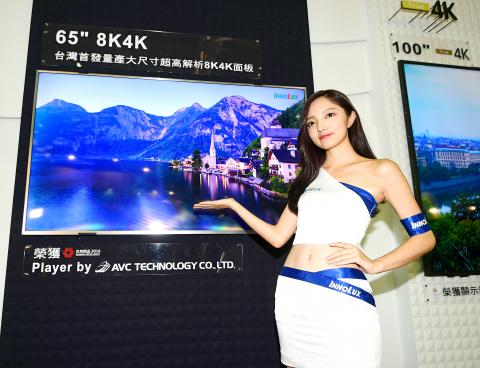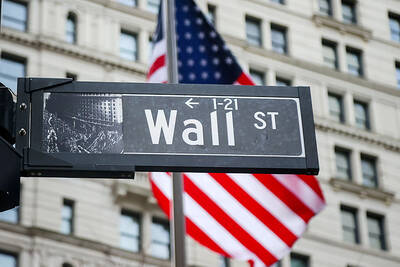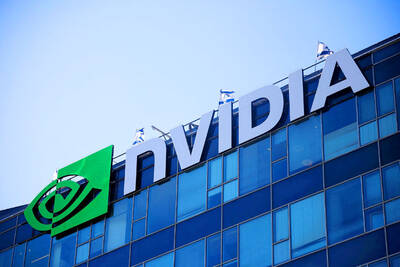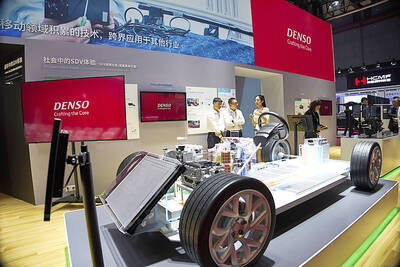Taiwan’s LCD panel makers are facing a bumpy road in developing next-generation technology as chances are fading that the government will support the costly development, a TrendForce Corp (集邦科技) analyst said yesterday.
The Ministry of Economic Affairs last month said that it was considering injecting as much as NT$10 billion (US$318.5 million) to help firms develop flexible active-matrix organic light-emitting diode (AMOLED) technology and to form a “national team” to build a supply chain to collectively support the development of the technology.
However, the government has been stuck in limbo since then, with no funding plan or development blueprint on the horizon.

Photo: Fang Pin-chao, Taipei Times.
“We do not have high hopes that the government will support the development,” TrendForce analyst Iris Hu (胡家榕) told the Taipei Times by telephone. “It is just a verbal commitment.”
In contrast to the inertia of Taiwan’s government’s, the Chinese and South Korean governments are aggressively assisting their LCD panel manufacturers foray into AMOLED technology as the investments will be several times higher than building an LCD production line, Hu said.
“For local LCD panel suppliers, which just emerged from chronic losses, the government’s funding will be critical,” Hu said. “Without the government bankrolling the project, things could become really difficult.”
AU Optronics Corp (AUO, 友達光電), the nation’s No. 2 LCD panel maker, last month highlighted the need for government support, as it would cost a company more than NT$10 billion to develop AMOLED technology.
“Not a single company from Taiwan can afford it on its own,” AUO chairman Paul Peng (彭双浪) said at the time.
The Hsinchu-based company told investors in July that it would stop wasting money on the development of large OLED panels and focus instead on producing smaller OLED panels used in wearable and virtual reality devices.
Innolux Corp (群創), in which Hon Hai Precision Industry Co (鴻海精密) has a major stake, recently said that it planned to develop flexible AMOLED technology, but it did not provide concrete details.
Analysts said it all depended on what resources Innolux could obtain after the tie-up of Hon Hai and Sharp Corp.
Sharp is developing OLED technology and is making better progress, they said.
“Taiwanese are losing ground in OLED to [South] Korean vendors,” CIMB Securities Ltd said in a report released earlier this month.
Most key equipment, critical material and production tools were fully booked by South Korean and Chinese firms for delivery over the next 18 months to 24 months, CIMB said, citing its recent surveys with OLED supply-chain firms.
Investors who expected Innolux to leverage Sharp’s IGZO technology for producing OLED mobile displays would be disappointed as the technology is suitable for producing OLED TV panels, but was unlikely to be commercialized within the next two years, CIMB said.
The brokerage said it was concerned about Taiwan’s LCD sector as the recent price uptrend is supported by seasonal demand, with the strength of price hikes appearing to diminish.

GROWING OWINGS: While Luxembourg and China swapped the top three spots, the US continued to be the largest exposure for Taiwan for the 41st consecutive quarter The US remained the largest debtor nation to Taiwan’s banking sector for the 41st consecutive quarter at the end of September, after local banks’ exposure to the US market rose more than 2 percent from three months earlier, the central bank said. Exposure to the US increased to US$198.896 billion, up US$4.026 billion, or 2.07 percent, from US$194.87 billion in the previous quarter, data released by the central bank showed on Friday. Of the increase, about US$1.4 billion came from banks’ investments in securitized products and interbank loans in the US, while another US$2.6 billion stemmed from trust assets, including mutual funds,

AI TALENT: No financial details were released about the deal, in which top Groq executives, including its CEO, would join Nvidia to help advance the technology Nvidia Corp has agreed to a licensing deal with artificial intelligence (AI) start-up Groq, furthering its investments in companies connected to the AI boom and gaining the right to add a new type of technology to its products. The world’s largest publicly traded company has paid for the right to use Groq’s technology and is to integrate its chip design into future products. Some of the start-up’s executives are leaving to join Nvidia to help with that effort, the companies said. Groq would continue as an independent company with a new chief executive, it said on Wednesday in a post on its Web

JOINT EFFORTS: MediaTek would partner with Denso to develop custom chips to support the car-part specialist company’s driver-assist systems in an expanding market MediaTek Inc (聯發科), the world’s largest mobile phone chip designer, yesterday said it is working closely with Japan’s Denso Corp to build a custom automotive system-on-chip (SoC) solution tailored for advanced driver-assistance systems and cockpit systems, adding another customer to its new application-specific IC (ASIC) business. This effort merges Denso’s automotive-grade safety expertise and deep vehicle integration with MediaTek’s technologies cultivated through the development of Media- Tek’s Dimensity AX, leveraging efficient, high-performance SoCs and artificial intelligence (AI) capabilities to offer a scalable, production-ready platform for next-generation driver assistance, the company said in a statement yesterday. “Through this collaboration, we are bringing two

Even as the US is embarked on a bitter rivalry with China over the deployment of artificial intelligence (AI), Chinese technology is quietly making inroads into the US market. Despite considerable geopolitical tensions, Chinese open-source AI models are winning over a growing number of programmers and companies in the US. These are different from the closed generative AI models that have become household names — ChatGPT-maker OpenAI or Google’s Gemini — whose inner workings are fiercely protected. In contrast, “open” models offered by many Chinese rivals, from Alibaba (阿里巴巴) to DeepSeek (深度求索), allow programmers to customize parts of the software to suit their